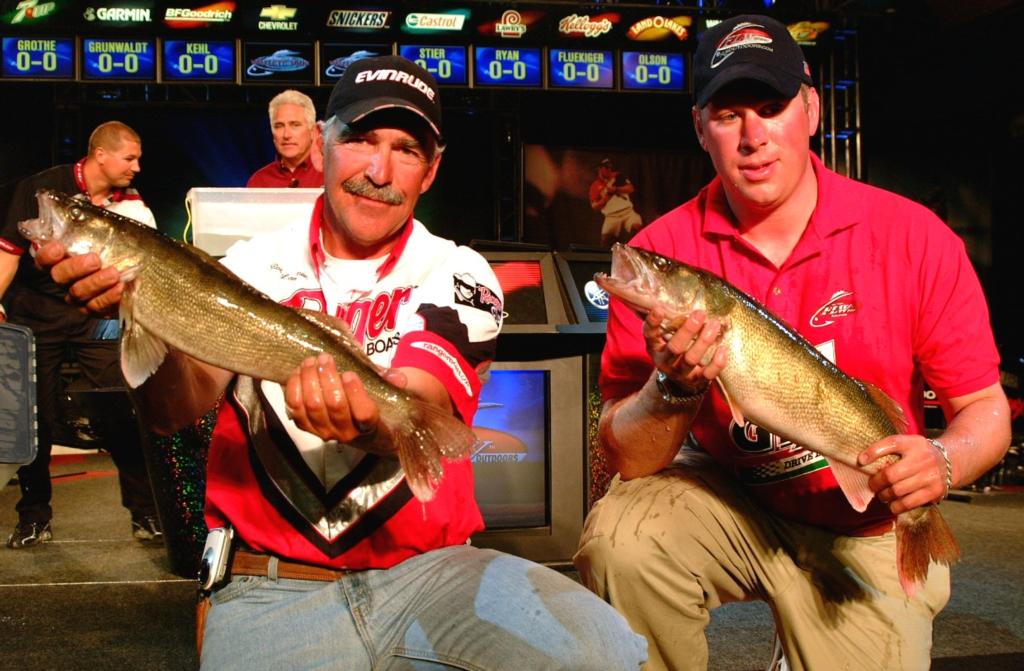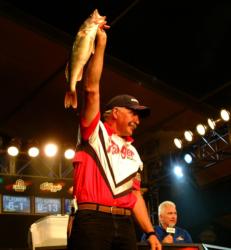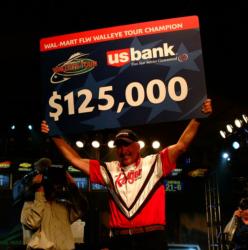Ask the Walleye Pro: Robert Lampman

Q: I fish a local cooling lake and the size limit is 16 inches. We catch a lot of 15-inch walleyes and once in a while a bigger fish but the majority are 15 inches. We’ve tried different tactics like jigging plastics and trolling crankbaits. We’ve even used bottom bouncers, crawler harnesses and leech rigs. Why can’t we find bigger fish than the 15-inch fish we catch on a regular basis? Any suggestions?
-Sonny Loepke, Chicago, Ill.
A: Think positive – with all those 15-inchers, you’re going to have a great fishing hole someday. I’m not quite sure what you mean by a cooling lake, so I will ask you some questions and they might help you locate fish. It sounds like you have a handle on varying your presentation to locate fish. Have you been watching the water temperature and making note of the structure as well as locating weeds and spotting baitfish? It might be a good idea to try a shallow crankbait. Are you watching your graph? Is it showing you fish on the bottom? Trust your electronics but remember that if you are not seeing marks on the bottom the fish could be suspended and therefore too close for the graph to locate. Here’s one more idea of a presentation to add to your arsenal – use a three-way rig with No. 5 to No. 9 original floating Rapalas. Work these crankbaits around the rocks. The main thing is to keep trying, that’s why it’s called fishing.
Q: What makes fishing for walleyes on rivers so different than lakes? Why do some guys do so well on rivers and others stink up the place? One guy that comes to mind is Scott Allar. The guy always does well on rivers. What does he know or understand about rivers that makes him that much better?
-Mitch, Lake City, Minn.
 A: Scott is good no matter where he goes, it’s called persistence. He is exceptional on the river and I believe a good river fisherman knows the bottom. He knows how to consistently find and feel the bottom with any presentation. To be consistently good on the river, an angler must understand the topography of the surrounding land along with the structure of the river bottom and the temperature of the water. Locating the swirls and eddies for deep water, reading the current and flow and understanding water levels are crucial elements in choosing the best presentation for the day.
A: Scott is good no matter where he goes, it’s called persistence. He is exceptional on the river and I believe a good river fisherman knows the bottom. He knows how to consistently find and feel the bottom with any presentation. To be consistently good on the river, an angler must understand the topography of the surrounding land along with the structure of the river bottom and the temperature of the water. Locating the swirls and eddies for deep water, reading the current and flow and understanding water levels are crucial elements in choosing the best presentation for the day.
To visualize where the big ones lie in wait of food is half the fun of fishing a river. If you follow the presentations used by the best “river rats” you will see everything from jigs, (vertical, pitched, and floating and as part of live-bait rigs) Lindy rigs, (using leeches, worms, or willow cats) three-way rigs, leadcore and handlining. These techniques all come into play when fishing Pools 3 and 4 where you have the unusual occurrence of a lake incorporated with a river.
The wing dams are great fishing if you can visualize the rocks, the breaks and the currents and become fearless about tossing a lure and having it bang its way through the rocks. Every angler has a favorite way to fish the river. Boat control is essential, location and presentation are critical and persistence and anticipation are required characteristics for conquering the Mississippi River. Then again, there is always that one holding spot that works magic for a few days – the one spot where you don’t have to move too much but you have to be positioned just right – the one spot that keeps you hoping year after year.
Q: In your opinion, what is the best walleye fishery in the United States right now? I’m hoping you say Lake Erie, but please give your honest opinion.
-Toledo Tom
A: Lake Erie has it hands down for catching lunker fish consistently, but Green Bay is fast approaching for the title of “Most Fantastic Walleye Fishery.” That’s my opinion and I’m sticking to it.
Q: I fished as a co-angler on Devils Lake and I saw a lot of the pros used fluorocarbon on their spinning reels. What specific type of fluoro would you recommend?
-Tom, Mandan, N.D.
 A: I use fluorocarbon for leads and three-way rigging. On Devils Lake, a lot of pros used Power Pro and Fireline on their reels to fight the trees when cranking lures. For bobber fishing, I rigged with 10- to 17-pound test fluorocarbon leaders to enable me to get my fish out of the trees. It all depends on where you are fishing but being from North Dakota, you know better than I what unusual things you can pull up from that lake. The versatility of presentations on Devils Lake is amazing. Half the fun is realizing it is a constant experiment to find the right line and right poundage for the right presentation. Next year I plan on writing down what worked in which spot. You only need to lose a couple to realize that line is critical not only in catching walleyes, but also for getting walleyes out of the trees and into the boat.
A: I use fluorocarbon for leads and three-way rigging. On Devils Lake, a lot of pros used Power Pro and Fireline on their reels to fight the trees when cranking lures. For bobber fishing, I rigged with 10- to 17-pound test fluorocarbon leaders to enable me to get my fish out of the trees. It all depends on where you are fishing but being from North Dakota, you know better than I what unusual things you can pull up from that lake. The versatility of presentations on Devils Lake is amazing. Half the fun is realizing it is a constant experiment to find the right line and right poundage for the right presentation. Next year I plan on writing down what worked in which spot. You only need to lose a couple to realize that line is critical not only in catching walleyes, but also for getting walleyes out of the trees and into the boat.
Q: When you’re fishing four slip bobbers in a tournament like Devils Lake, does the co-angler get to man any lines or does the pro basically control all four?
-Slipping Steve, Isle, Minn.
A: The co-angler in any tournament always has his own two poles to fish. As a pro, I might advise on how to set up the bobber, how to hook the leech so it swims nicely and where to place the line on the spot. We discuss how to set the hook and all the other things I learned from prefishing the area. We make note of where the net is to be kept so I can net his fish and he can net mine. I believe that the title co-angler is the best way to encourage two people to use all their competence in order to have a good day fishing together. I am a competition fisherman and it is critical that I rely on the co-angler to be the extra eyes and hands. No matter where we fish, you always have pros thanking their co-anglers for a job well done and an enjoyable day. That tells me that there is a camaraderie and appreciation for one another’s talents and abilities.
Robert Lampman is a veteran walleye pro from De Soto, Wis. A talented river fisherman, Lampman won the 2005 FLW Walleye Tour Championship on the Mississippi River near Moline, Ill. To date, Lampman’s career earnings with FLW Outdoors sit at over $160,000. In addition to the Walleye Tour, Lampman has also competed in team events on the Master’s Walleye Circuit with his wife Colleen. Lampman operates his own land surveying company, so when he’s not chasing walleyes, he is probably climbing the bluffs and measuring the coulees of western Wisconsin. His sponsors include Lampman Land Surveying, Ranger Boats, Evinrude, Minn Kota and Lowrance.